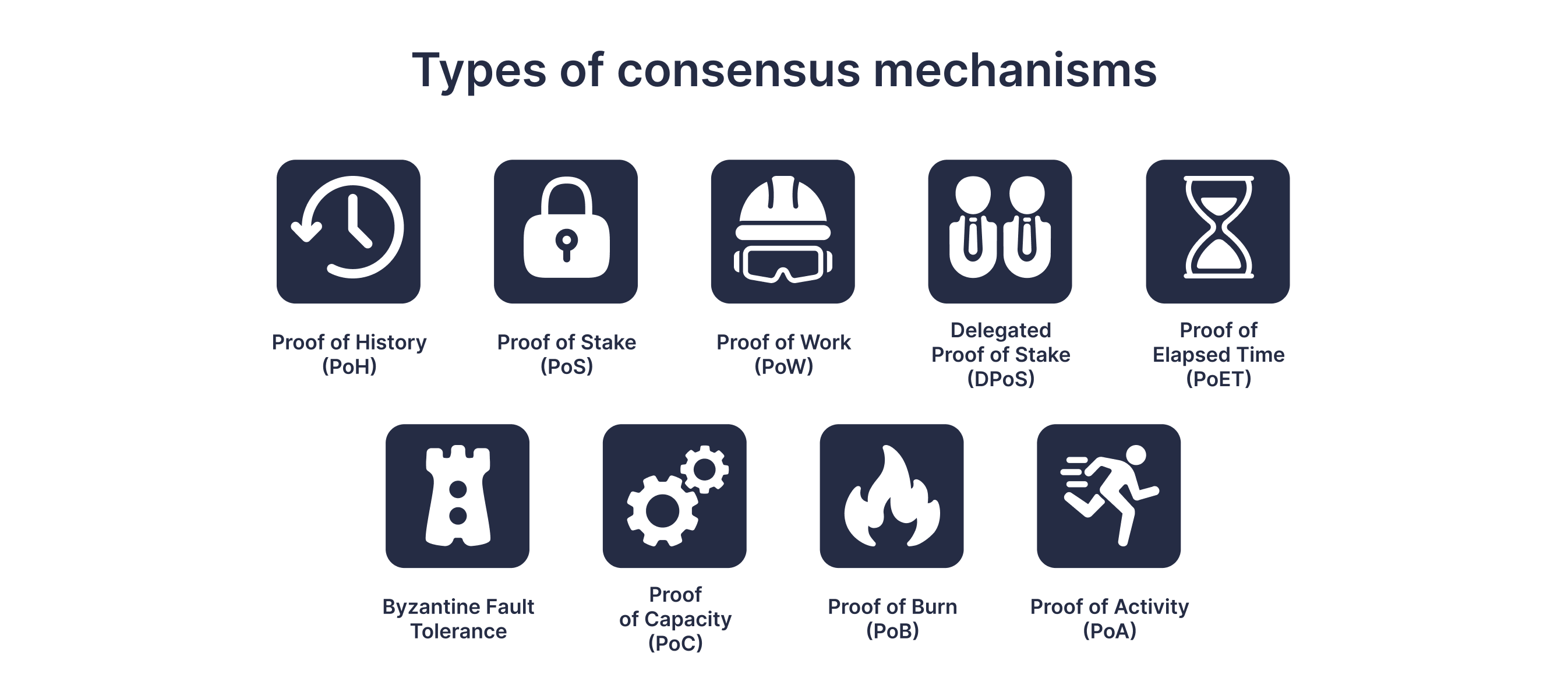A Guide to Consensus Mechanisms

This blog post will cover:
- Understanding Consensus Mechanisms
- Types of Consensus Mechanisms
- Other consensus mechanisms worth exploring
- Choosing the Right Consensus Mechanism
- What’s Next?
- Conclusion
In a decentralized setting, what lends credibility and dependability to blockchain technology? It's the consensus mechanisms, acting as the backbone, ensuring uniform verification and recording of transactions throughout the network. This piece delves into the diverse array of algorithms - proof of stake vs proof of work and many more, their pivotal role in upholding decentralization, and their contribution to fostering reliability and trustworthiness.
Understanding Consensus Mechanisms
At the foundation of blockchain technology lie consensus mechanisms, pivotal systems engineered to validate transactions within a blockchain network. To those wondering what is a consensus mechanism - its fundamental role is to optimize network performance and uphold its trustworthiness, functioning as algorithms that fortify and streamline the operation of blockchain networks.
Within each blockchain network, numerous nodes operate, each fulfilling distinct functions in validating transactions and generating fresh blocks. The choice of algorithm employed by these nodes to validate transactions is dictated by the prevailing consensus mechanism overseeing the network.
Types of Consensus Mechanisms
A variety of mechanisms exist, ranging from the widely known proof of stake (PoS) and proof of work (PoW) to more specialized alternatives. This section will explore both mainstream and less traditional mechanisms. Different types of consensus mechanisms offer distinct benefits and drawbacks concerning scalability, speed, and other factors - keep on reading to learn how to navigate the field.
Proof of Work (PoW)
PoW serves as the fundamental consensus protocol employed by Bitcoin, requiring miners to decipher complex mathematical problems to append new blocks to the blockchain. This method demands significant energy consumption and may foster centralization, as miners with greater computational capabilities possess a competitive edge in block addition. Despite these drawbacks, PoW has demonstrated its efficacy in thwarting double-spending activities, thereby upholding trust within the network.
Proof of Stake (PoS)
PoS offers a greener alternative to PoW, where validators, not miners, are chosen to forge new blocks based on the cryptocurrency they possess and commit to "stake." Ethereum 2.0 serves as a prime example of a blockchain migrating from PoW to PoS, aiming to bolster scalability and diminish energy usage.
Delegated Proof of Stake (DPoS)
Delegated Proof of Stake (DPoS) stands as an adaptation of PoS, wherein stakeholders delegate their voting rights to a select few delegates responsible for network security. This method offers improved speed and energy efficiency over PoW, though it may raise centralization apprehensions. Delegates oversee transaction validation and blockchain upkeep, facing potential removal by stakeholders for inadequate performance. EOS serves as a notable instance of a blockchain employing DPoS, enabling swift transaction execution.
Byzantine Fault Tolerance (BFT)
BFT mechanisms tackle the Byzantine Generals' Problem, enabling systems to operate seamlessly despite potential node failures or malicious activities. These mechanisms are particularly suited for permissioned blockchains, where participant identities are transparent, minimizing the possibility of Byzantine actions. Hyperledger Fabric, a platform tailored for enterprise blockchain applications, integrates a variant of BFT into its consensus mechanism.
IOTA Tangle
Implemented by IOTA, this algorithm operates on a Directed Acyclic Graph (DAG) framework, requiring users to confirm two prior transactions to execute their own. This eliminates the necessity for miners and transaction fees, rendering it ideal for microtransactions and applications within the Internet of Things (IoT) sphere. Nonetheless, its effectiveness hinges on a substantial transaction volume to sustain security and operational efficiency, which can be problematic for fledgling or limited-scale networks.
Hashgraph
Hashgraph employs a gossip protocol and virtual voting to operate its algorithm, providing advantages such as high throughput, equitable transaction sequencing, and resilience against Byzantine faults. Nevertheless, it is proprietary and solely utilized by Hedera Hashgraph, a public network necessitating authorization for access. Hashgraph serves as a testament to the customization of consensus mechanisms to suit particular needs and scenarios.
Other consensus mechanisms worth exploring

Proof of something (PoX) series: this category includes various proofs based on different resources, such as proof-of-storage, proof-of-bandwidth, and proof-of-elapsed-time. These methods utilize distinct resources to secure the network and reach consensus.
Hybrid: this includes various proofs based on different resources, such as proof-of-storage, proof-of-bandwidth, and proof-of-elapsed-time. These methods utilize distinct resources to secure the network and reach consensus.
Crash Fault Tolerance (CFT): these can tolerate nodes crashing or becoming unresponsive but do not address Byzantine faults, where nodes act arbitrarily or maliciously. They are typically used in trusted node systems.
Proof-of-capacity: this mechanism allocates mining and transaction validation rights based on the storage capacity a node contributes to the network, offering a more energy-efficient alternative to PoW.
Proof-of-activity: a hybrid model that combines PoW and PoS. Blocks are initially mined through PoW, and then a PoS-based random selection finalizes transactions.
Proof-of-burn: in this mechanism, miners earn mining rights equivalent to the amount of coins they 'burn' or make unspendable. It’s seen as an investment in the long-term health of the network.
Proof-of-personhood: this emerging and somewhat controversial mechanism links the consensus process to unique human individuals, giving each an equal say. It remains experimental and faces challenges related to identity verification and privacy.
Choosing the Right Consensus Mechanism
Opting for the appropriate algorithm in a blockchain network is pivotal as it profoundly impacts both its performance and security. Here are critical considerations to keep in mind:
Primary use case: assessing the intended usage of the blockchain is imperative to ensure alignment with the selected mechanism. For instance, Bitcoin employs PoW, whereas Ethereum has transitioned to Proof of Stake.
Security requirements: the mechanism's security level stands as a paramount factor. Mechanisms like PoW necessitate substantial computational resources to append a block, rendering retroactive alterations by malicious actors exceedingly challenging.
Scalability needs: when anticipating heightened transaction volumes, scrutinize the scalability of the mechanism. PoS, for instance, offers swifter transaction processing vis-à-vis PoW.
Cost of running the network: certain mechanisms, such as PoW, entail substantial energy consumption and computational demands, thereby exerting a notable influence on operational expenses.
Level of decentralization desired: consensus mechanisms engaging multiple nodes in the process elevate decentralization, a factor deserving meticulous consideration.
Community support: evaluate the extent of community support and adoption pertaining to the chosen consensus mechanism, as this can significantly influence its efficacy and long-term viability.
What’s Next?
The blockchain sector is swiftly advancing in consensus mechanisms. Hybrid approaches, amalgamating aspects of PoW and PoS, are gaining traction due to their endeavor to amalgamate the merits of various mechanisms in tackling their respective shortcomings.
Another promising domain lies in layer-2 solutions. These innovations operate above current blockchains and hold the promise of greatly improving scalability and transaction velocity. Illustrations encompass the Lightning Network for Bitcoin and Plasma for Ethereum.
Additionally, investigations into Proof-of-Stake mechanisms are ongoing, encompassing foundational comprehension to sophisticated protocols and evaluations of performance metrics like energy consumption, latency, and security. These endeavors offer potential for diverse applications, particularly in the realm of the Internet-of-Vehicles. Consequently, the progression of blockchain technology and consensus mechanisms persists as an area of active research, with anticipations of novel mechanisms emerging in the future.
Conclusion
Understanding consensus mechanisms is essential for anyone involved in blockchain technology. Regardless of the technology employed, the concept itself stands as the linchpin, guaranteeing the uniform verification and recording of transactions. As the field evolves, staying informed about new developments will be crucial for building secure and efficient blockchain systems. Continue exploring and learning about this dynamic area of technology with SimpleSwap.
SimpleSwap reminds you that this article is provided for informational purposes only and does not provide investment advice. All purchases and cryptocurrency investments are your own responsibility.

